
Ceratophyllum is a cosmopolitan genus of flowering plants including four accepted living species in 2016, commonly found in ponds, marshes, and quiet streams in tropical and in temperate regions. It is the only extant genus in the family Ceratophyllaceae, itself the only extant family in the order Ceratophyllales. They are usually called coontails or hornworts, although hornwort is also used for unrelated plants of the division Anthocerotophyta.

Rubus caesius is a Eurasian species of dewberry, known as the European dewberry. Like other dewberries, it is a species of flowering plant in the rose family, related to the blackberry and raspberry. It is widely distributed across much of Europe and Asia from Ireland and Portugal as far east as Xinjiang Province in western China. It has also become sparingly naturalized in scattered locations in Argentina, Canada, and the United States.

Hydrilla (waterthyme) is a genus of aquatic plant, usually treated as containing just one species, Hydrilla verticillata, though some botanists divide it into several species. It is native to the cool and warm waters of the Old World in Asia, Africa and Australia, with a sparse, scattered distribution; in Australia from Northern Territory, Queensland, and New South Wales.
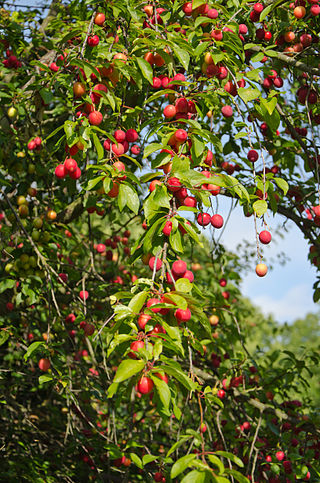
Prunus cerasifera is a species of plum known by the common names cherry plum and myrobalan plum. It is native to Southeast Europe and Western Asia, and is naturalised in the British Isles and scattered locations in North America. Also naturalized in parts of SE Australia where it is considered to be a mildly invasive weed of bushland near urban centers.
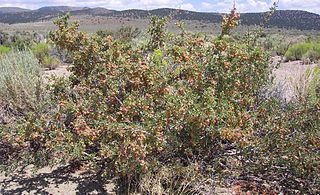
Prunus andersonii is a species of shrub in the rose family, part of the same genus as the peach, cherry, and almond. Its common names include desert peach and desert almond. It is native to eastern California and western Nevada, where it grows in forests and scrub in desert and mountains. It was named after Charles Lewis Anderson by Asa Gray.

Sonchus asper, the prickly sow-thistle, rough milk thistle, spiny sowthistle, sharp-fringed sow thistle, or spiny-leaved sow thistle, is a widespread flowering plant in the tribe Cichorieae within the family Asteraceae.
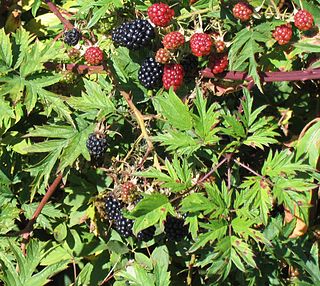
Rubus laciniatus, the cutleaf evergreen blackberry or evergreen blackberry, is a species of Rubus, native to Eurasia. It is an introduced species in Australia and North America. It has become a weed and invasive species in forested habitats in the United States and Canada, particularly in the Northeast and along the Pacific Coast.
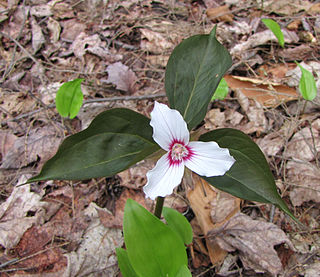
Trillium undulatum, commonly called painted trillium, painted lady, or trille ondulé in French, is a species of flowering plant in the bunchflower family Melanthiaceae. It is also known as smiling wake robin or striped wake-robin. The specific epithet undulatum means "wavy", which refers to the wavy edges of the flower petals. The plant is found from Ontario in the north to northern Georgia in the south and from Michigan in the west to Nova Scotia in the east.

Opuntia engelmannii is a prickly pear common across the south-central and Southwestern United States and northern Mexico. It goes by a variety of common names, including desert prickly pear, discus prickly pear, Engelmann's prickly pear in the US, and nopal, abrojo, joconostle, and vela de coyote in Mexico.

Platanthera blephariglottis, commonly known as the white fringed orchid or white-fringed orchis, is a species of orchid of the genus Platanthera. It is considered to be an endangered species in Connecticut and Ohio, a threatened species in Florida, Maryland and Rhode Island, exploitably vulnerable in New York, and susceptible to be threatened in Québec.

Ceratophyllum demersum, commonly known as hornwort, rigid hornwort, coontail, or coon's tail, is a species of Ceratophyllum. It is a submerged, free-floating aquatic plant, with a cosmopolitan distribution, native to all continents except Antarctica. It is a harmful introduced weed in New Zealand. It is also a popular aquarium plant.

Eupatorium sessilifolium, commonly called upland boneset or sessile-leaved boneset, is a North American plant species in the family Asteraceae. It is native to the eastern and central United States, found from Maine south to North Carolina and Alabama, and west as far as Arkansas, Kansas, and Minnesota.

Opuntia humifusa, commonly known as the devil's-tongue, Eastern prickly pear or Indian fig, is a cactus of the genus Opuntia present in parts of the eastern United States, Mississippi and northeastern Mexico.

Ranunculus gmelinii, Gmelin's buttercup or small yellow water-crowfoot, is a species of flowering plant in the buttercup family, Ranunculaceae. It is native to northern North America, where it occurs across Canada and the northern and higher-elevation regions of the United States. It is also present in Eurasia.
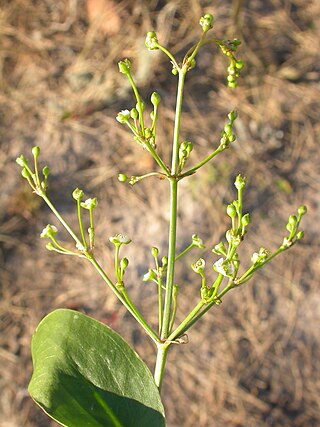
Alisma triviale, the northern water plantain, is a perennial semi-aquatic or aquatic plant in the water-plantain family (Alismataceae).
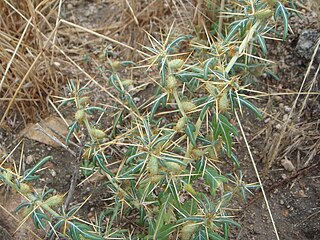
Xanthium spinosum is a species of flowering plant in the aster family known by many common names, including spiny cocklebur, prickly burweed and Bathurst burr. This species is part of the genus Xanthium that encompasses 25 different species of flowering plants of the daisy family, Asteraceae, and sunflower tribe.

Rubus flagellaris, the northern dewberry, also known as the common dewberry, is a North American species perennial subshrub species of dewberry, in the rose family. This dewberry is distributed across much of Canada, Mexico, and the United States. It grows in diverse habitats ranging from drier savannas to temperate deciduous forests.

Meconopsis horridula, the prickly blue poppy, is a flowering plant from the family Papaveraceae. It is an endangered species that grows in high altitudes. The height of the plant varies from 20 cm to 1m. It is a monocarpic, dicot plant.

Ceratophyllum submersum, commonly known as the soft hornwort or tropical hornwort, is a species of Ceratophyllum. It is a submerged, free-floating aquatic plant. It has been reported from Europe, Central Asia, northern Africa, scattered places in tropical Africa, Turkey, Oman, Florida, and the Dominican Republic. It is similar to the submerged macrophyte Ceratophyllum demersum, a congeneric plant that is found in most regions of the world.

Eremophila parvifolia is a flowering plant in the figwort family, Scrophulariaceae and is endemic to Australia. It is a shrub which has small, usually egg-shaped leaves and blackish flower buds which open to purple flowers which are white with purple spots inside. There are two subspecies, both of which are found in Western Australia and one which is also found in South Australia.



















